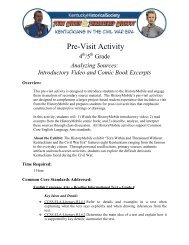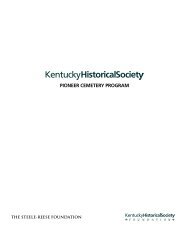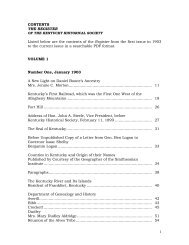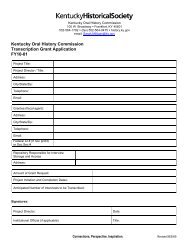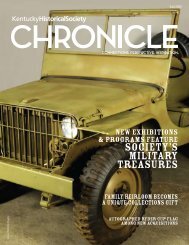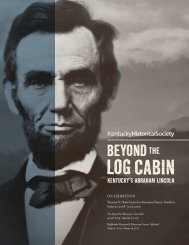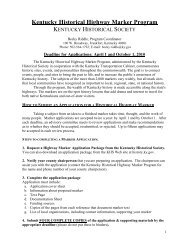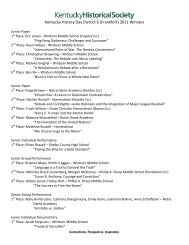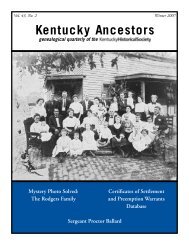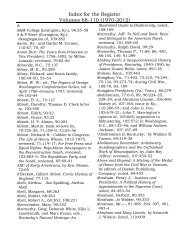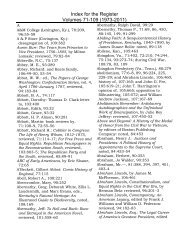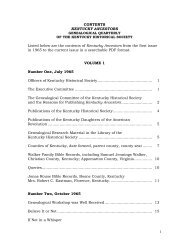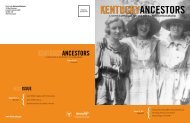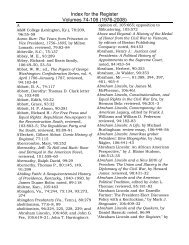Chronicle Spring & Summer 2008 - Kentucky Historical Society
Chronicle Spring & Summer 2008 - Kentucky Historical Society
Chronicle Spring & Summer 2008 - Kentucky Historical Society
Create successful ePaper yourself
Turn your PDF publications into a flip-book with our unique Google optimized e-Paper software.
Live the Traditions:<br />
The <strong>Kentucky</strong> Folklife Program<br />
What are the rules for Dainty, a traditional street game played in German<br />
American neighborhoods in Louisville? What is the secret to the distinctive<br />
sound of <strong>Kentucky</strong>’s handmade instruments? How do Kentuckians<br />
of Chinese descent incorporate their traditions into their families and<br />
communities?<br />
Working together with individuals, communities, and organizations, the<br />
<strong>Kentucky</strong> Folklife program staff travels throughout the commonwealth<br />
helping to identify, document, and conserve living cultural traditions like<br />
these.<br />
A joint program of the <strong>Kentucky</strong> <strong>Historical</strong> <strong>Society</strong> and the <strong>Kentucky</strong> Arts<br />
Council, the <strong>Kentucky</strong> Folklife program provides:<br />
• Fieldwork research and<br />
documentation of <strong>Kentucky</strong>’s living cultural<br />
traditions<br />
• Professional development and Folklife curriculum for educators<br />
• Community Scholar training programs to help Kentuckians<br />
discover, document, and present hometown traditions<br />
• Master Apprenticeships to encourage traditional artists and<br />
craftpersons to share their talents with future generations<br />
• Folklife grants offered through the <strong>Kentucky</strong> Arts Council, including<br />
apprenticeship, project, and performing arts on tour funding<br />
• Food, music, dance, art, recreation, and occupation are some of the<br />
cultural traditions examined through the <strong>Kentucky</strong> Folklife Program<br />
Recent results of the work of the <strong>Kentucky</strong> Folklife program are evident<br />
throughout the state.<br />
In Franklin County, master musician John Harrod spends months teaching<br />
another accomplished musician the art and techniques of traditional fiddling.<br />
This Folklife Master Apprenticeship program, funded with a grant from the<br />
<strong>Kentucky</strong> Arts Council, ensures that this musical folklife tradition lives on in<br />
a new generation.<br />
In Kenton County, the Folklife Community Scholars program helps local<br />
neighbors at the Center for Great Neighborhoods gather oral histories,<br />
archival photographs, and traditions celebrated at local festivals. Once<br />
collected, these resources are documented and plans made to present<br />
findings to the public. The resulting exhibit, Covington Neighborhoods:<br />
Folklife and Tradition, displayed last fall at the Kenton County Library,<br />
focuses on the food, recreational, occupational, music, and art traditions<br />
shared by six Covington neighborhoods—Austinburg, Wallace Woods,<br />
Eastside, Westside, Mainstrasse, and Latonia.<br />
In Estill County, <strong>Kentucky</strong> Folklife specialists help local citizens research,<br />
document, and present their local mushroom traditions. Their local<br />
Mountain Mushroom Festival now draws visitors from around the nation<br />
eager to participate in demonstrations on how to identify, harvest, process,<br />
and cook local mushroom delicacies. The resulting community pride in<br />
this living tradition enhances the local economy. Now, Estill Countians are<br />
applying their newfound folklife skills to agate hunting traditions in their community, fostering new<br />
opportunities for heritage and cultural tourism.<br />
Teachers gathered at the <strong>Kentucky</strong> <strong>Historical</strong> <strong>Society</strong> last fall to learn how to integrate folklife into their<br />
classrooms, and prepare classroom-ready folklife activities. Educators learned how to use real-life<br />
encounters and illustrations to teach their students history, music, art, social studies, and other<br />
topics. New bridges between schools and communities and students and their elders are the<br />
result. Students encounter and learn about diverse beliefs, customs, and traditions within their<br />
community.<br />
For more information about the <strong>Kentucky</strong> Folklife Program, visit folklife.ky.gov.<br />
14 | www.history.ky.gov |<br />
15



